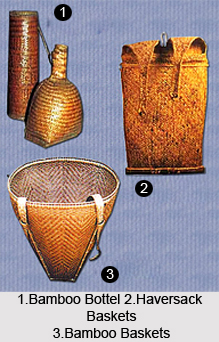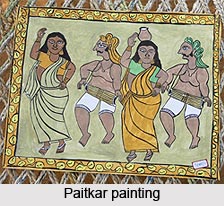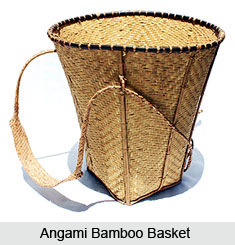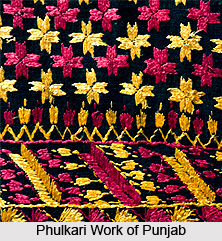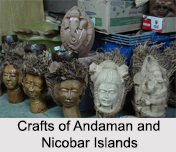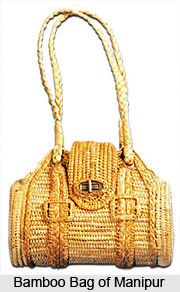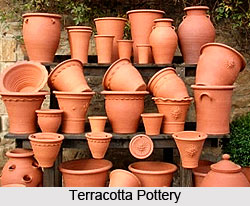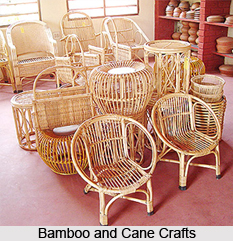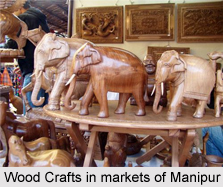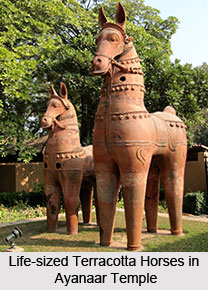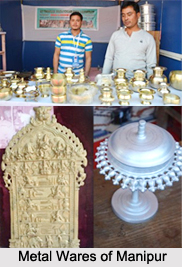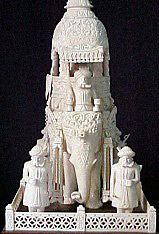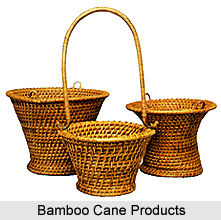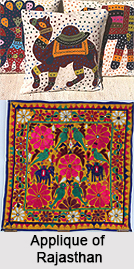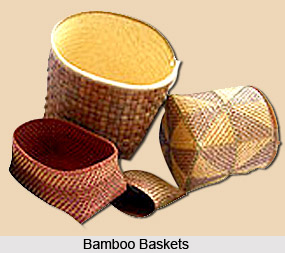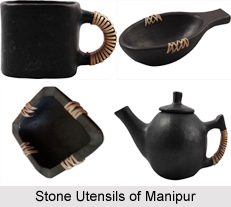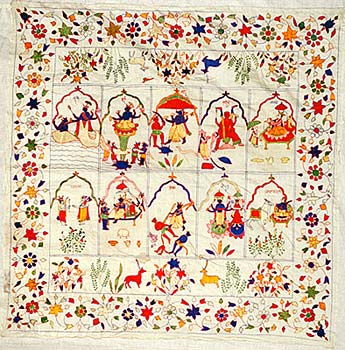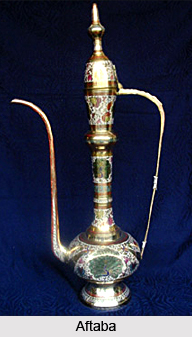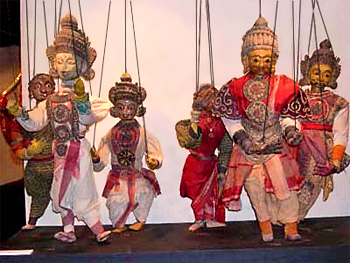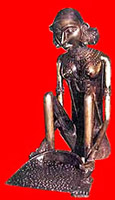 Bell metal is a hard alloy used for making bells. It is a form of bronze. Studies revealed that metal alloys have been in use for workshop art in India from time immemorial perhaps as old as the temple building activity itself. Bell metals are used to produce variety of items both for utility and aesthetic purposes. Indian Bell metal work is distinguished by ornate and sophisticated designs, finesse and finish. Bell metal casting in Madhya Pradesh is essentially a tribal craft, practised by non-tribals in Bastar, Pranpur, Datia and Sagar, originally for the requirements of tribals alone.
Bell metal is a hard alloy used for making bells. It is a form of bronze. Studies revealed that metal alloys have been in use for workshop art in India from time immemorial perhaps as old as the temple building activity itself. Bell metals are used to produce variety of items both for utility and aesthetic purposes. Indian Bell metal work is distinguished by ornate and sophisticated designs, finesse and finish. Bell metal casting in Madhya Pradesh is essentially a tribal craft, practised by non-tribals in Bastar, Pranpur, Datia and Sagar, originally for the requirements of tribals alone.
During the Gupta period the Kurkihar centre for brass and bell metal in Bihar was known throughout the world, and history records that two artists named Dhiman and Vithpal taught the craft to artisans from different countries in Asia.
Assam has special shapes and patterns of its own in metal-ware. The craftsman is called a kahar or orja, owns the tools and equipment in such establishment. Guwahati and Sarthebari are the important centres for bell metal craft. Brass work is an important Assamesse cottage industry with the highest concentration being in Hajo in Kamrup district.
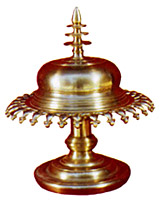 Old references date the bell metal craft of Manipur to the late 17th or early 18th century. It is a cottage industry and is virtually confined to two area of the valley, viz. Heirangkhoithong (at Chinga Makha) and Aheibam eikai (at Khongnang Pheidekpi). Both are about four miles south of Imphal and are three miles apart.
Old references date the bell metal craft of Manipur to the late 17th or early 18th century. It is a cottage industry and is virtually confined to two area of the valley, viz. Heirangkhoithong (at Chinga Makha) and Aheibam eikai (at Khongnang Pheidekpi). Both are about four miles south of Imphal and are three miles apart.
The antiquity of the use of iron in India is proved by its reference in earliest literature, the Vedas. Brass and bell metal articles required by the people are partly produced in Assam and Tripura. The craft is practiced in Agartala , Narshinggarh, Soonamura and Kailasahar.
Art of Bell Metal
The main feature of cire-perdue (lost wax) process is that the clay core is retained within the metal covering lending weight and strength to the product inspite of the thinness of the metal lay. The religious objects made in bell metal are mainly figures of tribal deities. Votive lamps, anklets, and turai (tribal bugles) are also made by the lost wax process.
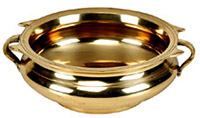 Kerala is the home of the bell-metal craft. The cooking vessels wide open with flat or curbed rims called urlis, are classic in line and dignified in their simplicity. Huge cauldrons called varpu are made for use in temples. It has also a great tradition of wide range of tumbles in many sizes, very elegantly shaped. There is a special jug, the lower part rounded in convolutions and a long spout jutting out at the side. In the ornamental line there are a variety of jewel boxes, oval or square, one with eight sides, fastened in front by a big bold ornamented chain, pan boxes, lime jars, each with a different artistic finish and floral or creeper design.
Kerala is the home of the bell-metal craft. The cooking vessels wide open with flat or curbed rims called urlis, are classic in line and dignified in their simplicity. Huge cauldrons called varpu are made for use in temples. It has also a great tradition of wide range of tumbles in many sizes, very elegantly shaped. There is a special jug, the lower part rounded in convolutions and a long spout jutting out at the side. In the ornamental line there are a variety of jewel boxes, oval or square, one with eight sides, fastened in front by a big bold ornamented chain, pan boxes, lime jars, each with a different artistic finish and floral or creeper design.
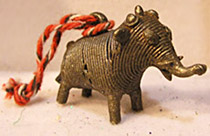 Two distinct types of products made in brass - ware and bell metal these days are cast pots and bowls with the lower half black or a natural dark colour. Dhokra articles, mostly figures of riders and elephant, candle stands, the fish type sindhur dan (vermilion box), etc., were made by the cire-perdue or lost wax process. The flexible brass and silver fish is a special item, made by a goldsmith community concentrated at Haveli Kharagpur in Monghyr district.
Two distinct types of products made in brass - ware and bell metal these days are cast pots and bowls with the lower half black or a natural dark colour. Dhokra articles, mostly figures of riders and elephant, candle stands, the fish type sindhur dan (vermilion box), etc., were made by the cire-perdue or lost wax process. The flexible brass and silver fish is a special item, made by a goldsmith community concentrated at Haveli Kharagpur in Monghyr district.
A shallow bowl on a stand is a typical item in both brass and bell metal called horay. It has delicate motifs on the sides or sometimes on the cover. Donari (look like pendants) is essential at weddings, to be given with dowry.
Krishna Kanti is a dish in the shape of a large bowl, with a broad encircling rim at the neck,resting on a small pedestal. Senga is a lidded betelnut container, which looks like a ritualistic lamp. An article with very chaste lines is a large bell with Garuda at the top. Similar patterns are made with dots, line and circles with a hammer to form attractive ornamentation both on the borders, as over the surface.
Bell metal is most attractive with its soft surface and the old gold tint. It is used in cooking dishes and eating plates as it does not tarnish and needs no tinning like copper.
Procedure of making Bell Metal
The bell metal articles are cast by the cire-perdue process. The core of the figure is roughly shaped in clay. Instead of laying on the wax in an even thickness, thin wax threads are first made. These are arranged over the core so as to form a network or placed in parallel lines or diagonally, according to the form of the figure. The head, arms and feet are modelled in the ordinary way. The wax threads are made by means of a bamboo tube into the end of which a moveable brass plate is fitted. The wax made is soften by heat. It is then pressed through the perforation at the end of tube and comes out in the form of long treads, which must be used by the workmen before they become hard and brittle.
The shaping of an object is done either by beating with a hammer the ergot or sheet metal to the approximate shape while heating, or by pouring the molten metal into a made of clay for ordinary ware, wax for more delicate objects. The beating process is often preferred for bell metal and copper to make the object more durable. It can also be subjected to further tempering for strengthening, by heating the article red hot and suddenly dipping in cold water. If it turns black in the process, it is rectified by light hammering. There is also the turning process done on the lathe, often worked by a string. The part of the article to be turned is fixed to the outer end of the lathe by gum. As the lathe rotates, the chisel is applied to the part requiring turning. It not only cuts away the unwanted bulk but also smoothens the article by scraping and brushing. Soldering is done by using a metal allay which the artisan himself prepares where articles are manufactured in several pieces which have to be joined together to form a composite whole. After this, polishing is done by vigorous rubbing, either by hand or if it is plate by feet, using a rag.
A mould made of clay mixed with husk is made of the object to be cast, which is then dried and polished, wrapped in a cover of fragile melted bee wax wires. When the wax is finally melted as also a pouring channel for the molten metal to pre-empt the vacated space in the final casting. Several coatings of clay are applied and dried until the clay mould gets leather hard, after which the wax is melted out. The molten metal is then poured into the voided replica chamber while the mould is kept red hot. The article is then ready.
Bihar artisans use a mixture of wax and resin and also pitch from coal tar. They mix two kilograms of pitch with 250 grams of resin, melt the two items and strain them separately. Then they mix the two and heat the mixture over fire, stirring it all the while. This process of mixing takes two hours or sometimes more. The mixture is strained again before using. The manner of use of this mixture is identical with that of resin. These artisans are very precise in their work and follow their technique meticulously.
Artifacts made from Bell Metal
Figures of tribal deities, votive lamps, turai (tribal bugles), peacocks, chameleons, cobras, deer, horses, human beings, musicians, ornament boxes, rice measure bowls, animals figurines etc. utensils, jewel boxes, ornamental chain, lime jars, lamps, floor stands, various shallow bowls of hemispherical shape.
Figures of riders and elephant, candle stands, fish type sindhur dan, vermilion box, kalash , water pot, sarai , a platter or tray with or without cover, tray, tau , a kind of vessel for cooking, lota, kahi , a dish, tal, musical instrument , bells, shields, swords, daggers, swords, hilts pan boxes, sengabetel container, Krishna kanti dish etc.
